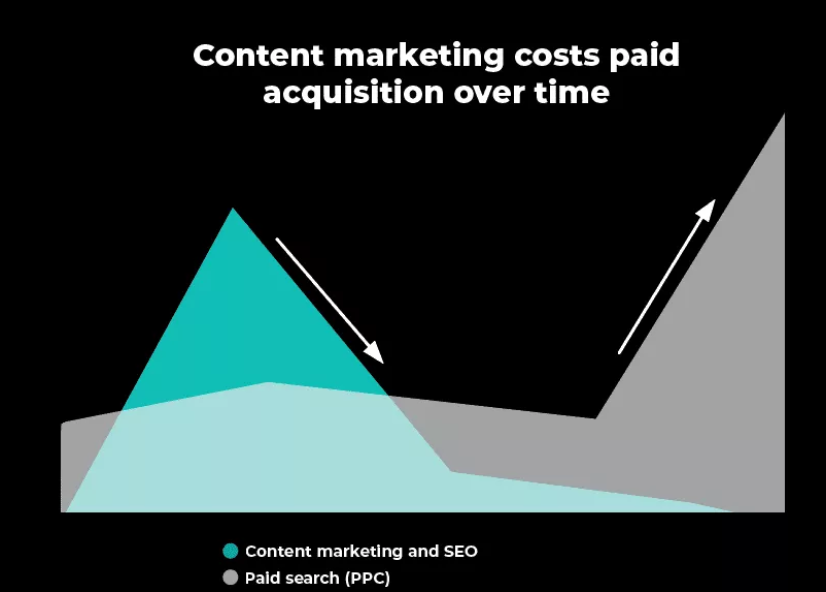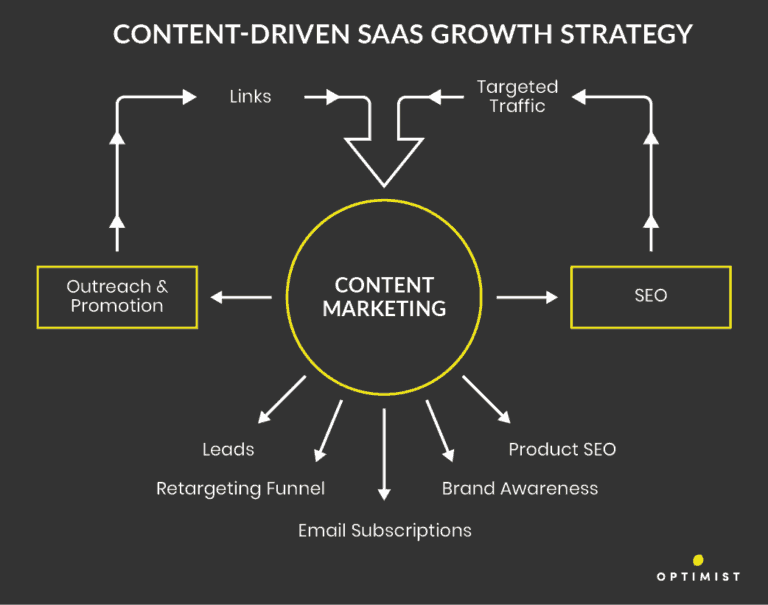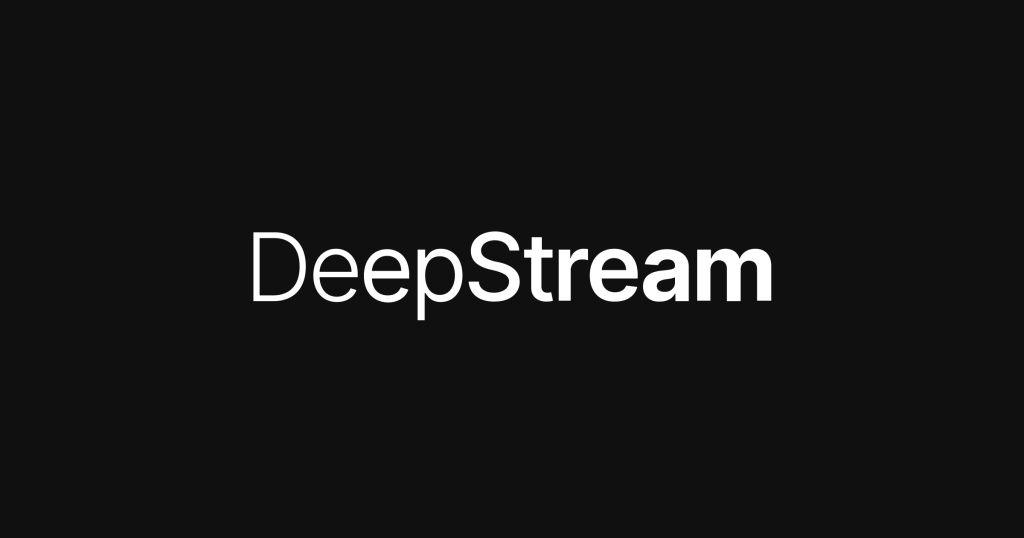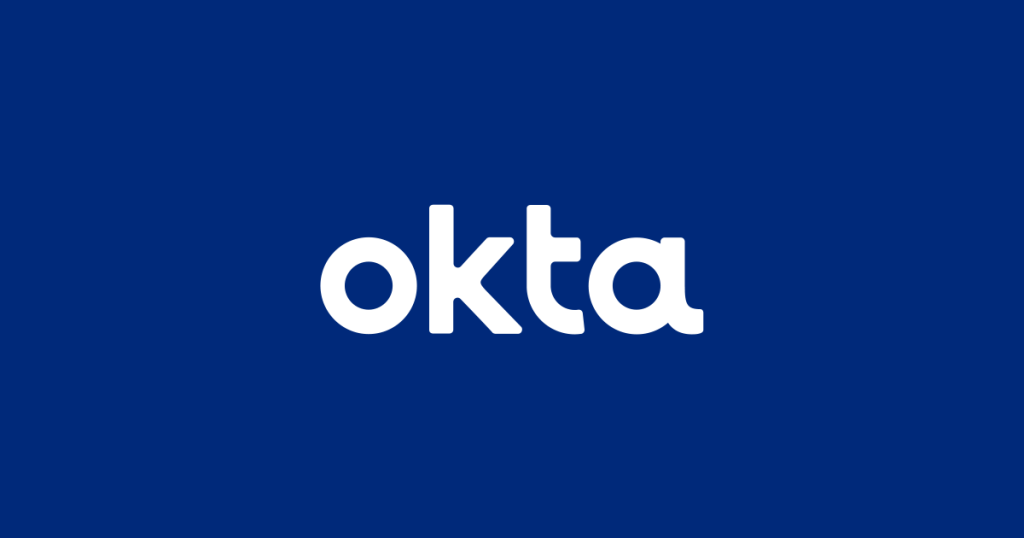
In today’s age, software-as-a-service companies are popping up left and right. That’s primarily due to the effectiveness of the SaaS business model. It involves remotely delivering your software through cloud-based apps with paid, recurring subscriptions.
With a SaaS business – both parties benefit.
Your users get to enjoy your software without having to worry about maintenance. All the infrastructure, updates, and data get handled by your data center.
You benefit by getting an app up and running at a low upfront cost, then improving it along the way.
Yet, with the abundance of SaaS companies out there, the competition is fierce. If you want to stand out and gain an audience – you’ll need a robust marketing strategy.
In particular, SEO should be the cornerstone of all your efforts.
Why’s that?
It’s because you need to get your app in front of the right eyeballs. The most reliable way to do that is by generating quality traffic through an intelligent SEO strategy.
If you want to learn how to develop killer long-term leads for your SaaS company, you’re in the right place. Stay tuned to learn how you can leverage SEO for SaaS.
Which Section Do You Want To Read First?
Deep Understanding = SaaS SEO Clients’ Success
SEO for SaaS is nothing new to me. In fact, I’m well aware of the unique SEO needs of SaaS companies. I acquired this knowledge the best way – through hands-on experience.
Thanks to my savvy SEO skills – these SaaS companies saw a significant increase in quality traffic, promising leads, and sales
4 Reasons SaaS SEO is an Ideal Marketing Channel

Do you want to see some evidence about the effectiveness of using SEO for SaaS? If so, you’re in luck. I’ve prepared four of the most significant reasons SEO is the perfect marketing channel for SaaS.
These aren’t random reasons I devised in the shower this morning, either.
Each reason comes from the deep experience I’ve had with SaaS companies.
You know why SEO is so effective for SaaS? It’s predictable, easy to scale, and can provide exponential growth. SEO will help you break away from the addiction of paid ads as well.
That way, you’ll end up putting your marketing budget to better and more efficient use. Here are the top 4 reasons you should start using SEO for SaaS.
1. Predictable + Scalable + Exponential SaaS SEO Growth
The beautiful thing about SEO is that it’s predictable. Other advertising methods, such as affiliate marketing and PPC, are often wildly unpredictable.
- You may bring in tons of sales with affiliate links – and then everything goes cold.
- Or you may see a sudden burst in organic traffic and may attribute it to your PPC ads.
Yet – these methods are hard to predict.
Bear in mind; not every webpage will generate the same traffic volume. It’s the search patterns and trends that are highly predictable.
That’s good news – because it means you can actively anticipate boosts in traffic.
There are plenty of analytical tools that you can use to monitor your success. Moreover, an experienced consultant can help you get the most out of your efforts.
Since SEO is predictable, it’s far easier to establish a budget and timeline for it. You’ll also have a better idea of when you’ll start to see an ROI. It’s all about setting you up for the long term.
That way, you can start to scale your business as you gain more and more traffic.
What’s even better is that proper SEO tactics have exponential effects (if you stick with them over time). Once you start seeing boosts in traffic and sales, your impact will scale.
All the actions you take from then on will build on your established success. If you plan to grow your business any time in the future, SEO strategies will play a vital role in your progress.
2. Building SaaS Business Brand Awareness 24/7/365
Another significant perk is that you’ll actively be building brand awareness around the clock. That’s one of the great things about SEO efforts – they don’t stop while people sleep – and they don’t go away. Building brand awareness is crucial for SaaS since it’s such a competitive industry.
Not only are more SaaS companies showing up – but they’re worth more overall. The valuation of SaaS has skyrocketed in recent years – and there’s no sign of its slowing down.
That’s why you need to implement a vetted SEO strategy to stand out from the crowd. It would be best if you built a brand that’s recognizable, relatable, and reliable.
One of the most effective (and affordable) ways to build your brand is to use SEO. The goal is to gain as much organic traffic as possible for your targeted keywords.
Your strategy should go well beyond placing a few keywords in your content, though. That won’t do much for your search rankings or building your brand.
Instead, your approach to SEO should include:
- Creating engaging content that informs, educates, and entertains
- Using cutting edge UX practices (cause that affects SEO these days)
- Finding keywords that don’t have a ton of competition but still relate to your niche
- Building a respectable backlink profile with a high domain authority
- Using analytical tools to monitor your progress and success
By engaging in these practices – you’ll improve your visibility in the search as well as build your brand. As stated before, SEO efforts have a compounding effect over time. The same is valid for improving the visibility and reliability of your brand.
3. Reduces CAC/CPA Costs (Over Time) + Less Dependency on Paid Channels

What’s your customer acquisition cost (CAC) like now? Is your cost per acquisition (CPA) higher than you’d like it to be at the moment? Then you should know that solid SEO efforts can lower both costs for you.
How’s that?
It has to do with the compounding effect mentioned before. All your efforts toward your SEO will continue to build on what you’ve done in the past.
If you’re able to gain more and more organic traffic through SEO – you won’t need to spend as much on advertising. Plus, fewer and fewer customers want to see ads (be sold).
The result? Your CAC and CPA will both go down. You won’t have to invest as heavily into other marketing channels due to your success with SEO.
It will also lower your dependency on pay-per-click ads. As the two graphs above illustrate – the CAC and CPA for SEO significantly go down over time. Conversely, the same costs for PPC see a sharp rise as time goes on.
If you’re struggling with your CAC and CPA for your paid ads – it’s time to make the switch. That way, your costs will go down over time, not the other way around.
In general, paid ads tend to be a sort of a ‘short-term band aid‘ for generating traffic and sales. They can work for a short-term boost – but they’re a terrible long-term strategy.
SEO is just the opposite. It takes a while for things to get going, but the benefits are enormous once they do. You’ll continue to receive more traffic, leads, and sales – yet your cost per lead/sale will go down.
4. SaaS SEO Strategy Amplifies + Feeds All Other Marketing Channels

As you can see – a robust SEO strategy yields many benefits. That’s not to say that you should abandon all other acquisition strategies in favor of it. In fact, your SEO will support and provide a boost for your other channels.
It will help if you strive for a well-rounded plan that includes a variety of strategies. Email marketing, social media, and influencer outreach are all channels SEO can support.
Here’s an example of how SEO can enhance your other acquisition channels. You have a squeeze page where you try to capture user email addresses. That way, you can build an email list to market your products.
Well, if your SEO provides you with lots of organic traffic – you’ll capture more email addresses.
Another example would be sharing the blog posts you created for SEO on your social media pages. If you did it right and wrote blog posts that inform – they’ll help increase your engagement on social media.
Beyond that, optimizing your product pages for SEO will have a two-fold effect. You’ll enjoy a boost in traffic – but you’ll also increase your conversion rate. A clever SEO strategy combined with optimized product pages can have a powerful effect.
So if you want to increase your other acquisition channels’ effectiveness, you need to use SEO. You can increase conversion rates and engage with a new audience. The steady stream of traffic will assist all efforts for acquiring customers.
Connect to Explore How I Can Guide Your SEO
12 SaaS Tips You Must Master for SEO Campaign Success

All right – now that you know why search engine optimization is worth your time, you need to know the correct way to go about it. There are plenty of ways to do it – but I’ve come up with a winning formula that’s worked for me time and time again.
This strategy is one that took years of experimenting plus trial and error to form.
Luckily, you don’t have to take all that time and effort to understand what I learned.
I’ve compiled 12 essential tips for your SEO campaign to make things nice and digestible. That will help you avoid all the beginner traps and pitfalls that claim so many.
Remember, it’s a lot more complex than injecting a few keywords here and there. You’ll need to use link building, create new articles, email outreach, and more.
Also, it’s crucial to follow these steps in sequential order. Otherwise, you can wind up trying to run before you can walk. Without further ado, here are the 12 most critical tips for mastering a SaaS SEO campaign.
1. Set Your SaaS Website SEO Goals & KPIs

The first step is to decide where you want to be once your SEO kicks in full gear. If you don’t have a clear goal in mind, you’ll be working in the dark and won’t know if you’re on the right track.
Also, it’s not enough to set a vague goal such as ‘increase revenue’ or ‘gain more traffic.’
Those approaches aren’t specific enough to help you out. For a goal to work, you need a clear idea of what you want and how you’ll get there within a specific timeframe.
The purpose of setting goals is to help devise a roadmap to your success. That way, you’ll know which direction you want to head out on your SEO journey. Here’s a quick example of a SaaS website goal:
- You want to increase your organic traffic conversion rate from 8% to 16% over the next 12 months.
That’s a goal that gives you something to strive for and measure yourself against. It’s far more realistic and specific than “gain more SEO traffic.”
Your goals are the starting point for your entire SEO campaign. It also gives you a metric you can monitor to analyze the effectiveness of your tactics. Notice I said ‘goals’ there – as it’s essential not to limit yourself to just one. Have a brainstorming session with your team to determine what you want to improve.
Beyond setting specific and realistic goals – you’ll need some reliable KPIs for your SEO too.
You can think of your KPIs as snapshots of your progress toward your goal. Here’s a list of a few core KPIs for your SEO:
- Search rankings and visibility. How easy is it for your customers to find you on search engines? It’s critical to keep a close eye on your ranking and how easy it is to find your site. Ahrefs is a great tool to use to keep track of this KPI.
- Organic traffic. This is arguably the most crucial KPI to monitor for your SEO. It’s likely also one of your primary goals for running an SEO campaign. It measures how many users visit your website through organic searches. To keep track of your organic traffic – use Google Search Console.
- Health of your backlink profile. You won’t succeed with SEO if you don’t build a backlink profile. Link building is more intricate than getting as many links as you can. Rather, each URL has a domain authority – either low or high. Low-authority pages can either help a little or hurt (depending on quality) your SEO instead of helping it – so strive for high-authority pages. You can also use Ahrefs to check the health of your backlinks.
- Bounce rate. That refers to how many people click off your site without taking any action. Typical bounce rates hover around 40% – 60%. If your bounce rate is higher than that – it’s a sign that your page isn’t as relevant as it could be to the search query. You can use Google Analytics to discover your bounce rate.
These are not all the KPIs for SEO – but they’re some of the most common. On the SaaS side of things, you should pay attention to:
- MQLs (Marketing Qualified Leads)
- SQLs (Sales Qualified Leads)
- MRR (Monthly Recurring Revenue)
- CAC (Customer Acquisition Cost)
- ARPU (Average Revenue Per User)
These are all relevant KPIs for the SaaS space, so it’s a good idea to keep an eye on them too.
2. “Don’t Pass Go” Until You’ve Performed a Technical SEO Audit

Before you do anything else, you’ll need to bring everything to a halt so you can conduct a technical SEO audit.
What’s that?
It’s where you take an in-depth look at the technical aspects of your website and software. During this audit, you scour your website (or websites) for technical issues that will affect your search rankings and visibility.
A thorough technical audit is a core part of any SEO strategy – not just for SaaS.
Many factors will affect your search rankings – and some aren’t entirely obvious. For example, if your content is too thin (under 200 words), Google won’t even bother to index it.
If you’re counting on thin pages to rank, that can be a crushing blow.
When crawling your website, Google is looking for purposeful content that’s trustworthy. If you notice an abundance of pages with less than 200 words – you need to change that as soon as you can.
Each page should have at least 700 words. You should also add internal/external links and relevant images. Finally, embedding videos is another way to boost your content.
Page speed is another significant issue to consider. During your technical audit, you’ll need to uncover how fast your page loads on browsers and mobile devices. You see, Google runs a series of tests on each page to determine if they load quickly enough.
Modern internet users expect pages to load fast. Google knows this and doesn’t want to waste users’ time with pages that take forever to load.
That’s why Google runs the Core Web Vitals test. It’s a series of diagnostics that determines if your page is fast enough to show up on Google.
To discover how easy it is for Google to find and index your website, you can use the Google Search Console. Also, uploading your sitemap to the Search Console will guarantee that Google has visibility of your website.
3. Understand Your Target Personas & Their Pain Points
SaaS SEO is unique in that it’s all about identifying personas and problems. What I mean by that is your software purchasers will have different personas. These are people that will benefit from using your software.
Why will they benefit from it?
They will because it solves a core problem or issue. Your strategy is all about convincing the personas that you can solve their problems. Make sense?
It’s crucial to find the right personas to target for your campaign. If you target the wrong audience – they may check out your content, but they won’t sign up for your service.
If you don’t solve the right problem, your targeted personas won’t go further down your funnel.
So for your SaaS SEO strategy to work, you need to identify your unique personas and problems. If this still sounds confusing – let’s consider a simple example.
Let’s say that your SaaS company offers project management software. Your personas would be anyone looking to manage a project successfully. Their problem is that they have a massive project coming up, and they don’t feel organized. Therefore, your service is perfect and solves their primary problem.
4. Have 2-5 Key Team Members Take a Keyword Survey
Next, assign 3-5 staff members to take this keyword research survey. It will help you identify some relevant keywords, but don’t use those on your website. You need to take this “seed keyword” list and run it through a proper keyword research tool like Ahrefs. Then once you whittle down that list, use a primary keyword to create each new page.
- The survey takes into account a few factors. These include:
- Targeted keywords for making a purchase
- Targeted keywords for finding relevant content
- Direct competitors in your niche
- Indirect competitors related to your niche (media sites, industry pubs, etc.)
As you can see, the survey will determine which keywords are best for purchases or finding content. It will also help you gauge your direct and indirect competitors to arm you with new SEO related topics for content articles.
Don’t forget to take your keywords and run them through a proper tool for keyword research. That could be SEMRush, Ahrefs, or another tool. That will help you further refine your list to ones you have a high likelihood to rank for.
5. Perform Competitor Research: Keyword Gap & Overlap Analysis
Now that you have a targeted list of keywords in mind, it’s time to see how you stack up to competitors. It’s crucial to look at both direct and indirect competitors here.
What’s the difference?
A direct competitor sells the same thing that you do. If you’re a SaaS company with an app for project management – a direct competitor will have one too.
That means you’re both competing for the same spots on Google – and you’re after the same customer base.
An indirect competitor is related to your niche but doesn’t sell what you do. An example would be an industry or media site reporting on project management. Their content contains similar search queries – so you’ll compete in that regard.
SEMRush’s Keyword Gap tool lets you compare your keyword profile with competitors.
Enter competitor domains as well as your own, and you’ll get to see a side-by-side comparison of keywords as well as what pages they are getting SEO traffic from.
You’ll get to see which keywords competitors are ranking for and that you aren’t – and vice versa. That will help you gauge your current success against your competitors.
Keyword Overlap occurs whenever two profiles overlap. SEMRush visualizes this with intersecting circles. When you click on a particular intersection, you’ll get a breakdown of all the keywords within it.
Connect to Explore How I Can Guide Your SEO
6. Have a Keyword Research Process (In Addition to Competitors) Based on Survey Responses

Your answers to the survey in step 4 will play a significant role in your research process. Of course, you should always pay attention to what your competitors are doing. Yet – that alone isn’t enough for your research process.
Focus on these other areas of keyword research as needed:
- Content articles
- Home page
- Product/service detail pages
That way, you’ll also know which keywords you should use for each page type. Having a robust keyword research process such as this will help you stay one step ahead.
7. Place Target Keywords/Topics in Clusters/Buckets + Funnel Stages

The days of targeting a few select keywords across your entire site are over, as is keyword stuffing on each page. Google’s natural language processing is savvier than ever – and it understands that you will likely need separate pages to satisfy different search intent.
In other words, Google is ranking each page on your site for a handful of keywords but usually not a lot. You want to target 1 primary keyword and a handful of secondary keywords for each page you create – if you try to get too many keywords to rank on one page, you’ll confuse Google.
The idea with keyword clusters is to organize similar keywords/content together but still have separate articles for each topic. These are groups of keywords that are about a similar yet somewhat broad topic.
An example would be “bedsheets” would be the main topic of that grouping and “how to sew linen sheets” and “bedsheets for king bed”. Each subtopic is a different way of saying that you want to buy bedsheets.
If you only attempt to rank for ‘bedsheets,’ you’re leaving a lot left on the table.
Instead, use a keyword cluster for it. Do that, and you’ll end up ranking for 10-20x more keywords (across multiple pages) – and as a result – generate more traffic.
You should also pay attention to what keywords you choose to target and make sure that aligns with various stages in your sales funnel. There are 3 primary funnel stages to consider.
1. Problem-Solution Keywords (Top of the Funnel or TOFU)
At the tip-top of your funnel, your prospects are looking for solutions to their problems (not ready to purchase anything). The chances are high that your prospects don’t know about your platform or your competitor’s either. If your SaaS focuses on project management – top funnel keywords might be:
- Project management process
- The best project management tips
- How do I improve PM efficiency
These searches aren’t to find your specific platform, but they aim to solve a problem. These keywords are what you can use to build awareness for your brand. A good rule of thumb for these keywords is to use them in blog posts.
2. Solution-Product Keywords (Middle of the Funnel or MOFU)
The next stage is when your customers know there’s a solution out there – but don’t know where to look yet. These searches and keywords revolve around finding the solution to their problem. In other words, they’re looking for a product just like yours. Going with the example above, middle of the funnel keywords would look like this:
- Project management software
- Best project management tools
- Project management for (INSERT INDUSTRY)
As you can see, your prospect is now after tools that will solve their problem. For these keywords, your product/service and some blog pages will be the focus.
3. Product Comparison and Purchase Keywords (Bottom of the Funnel or BOFU)
All right, now we’re at the bottom of the funnel. That means your potential customers are finalizing their decisions. Keyword-wise, the prospects know that your product exists. For this reason, they’ll use keywords with purchase intent, including your brand. For our example, let’s say the name of the software is Project Manager Pro. The bottom of the funnel keywords would look like this:
- Project Manager Pro pricing
- Project Manager Pro reviews
- Project Manager Pro competitors
This stage is your final chance to convert the prospect into a paying customer.
8. Prioritize Content Marketing Editorial Calendar Based on Business Goals + Quick(er) Wins (Lower Competition)

You’ll need to create a content marketing strategy + calendar to keep track of your release dates. You’ll want to regularly release new SEO-focused articles based on your business goals. If your goal is to increase your conversion rate from 8% to 16% – your calendar should have some bottom of the funnel
An example would be releasing content that aims to convert the prospect to an email lead. It should still be informative – but include a strong call-to-action (CTA) at the end. That will encourage readers to sign up for more info (articles via email) while they consider your service.
You should also prioritize “quick wins.” As stated before, SaaS SEO is all about the long-term. That means it’ll take a while before you start seeing results.
To see some immediate results to hold you over – go for quick wins. These are easy ways to score some quick boosts in traffic. Auditing your current content to find pages that are in “striking distance” of more traffic (on page 2 of Google) is an excellent quick-win strategy.
9. Create Content + Publish “Best of the Web” Articles to Crush Your Competition

It’s time to start creating your content. In doing so – you should have one goal in mind – and that’s to crush the competition.
The world of SEO is a highly competitive one. Companies are always trying to outdo each other with the quality of their content.
If you want to outrank a competitor – you’re going to have to outdo them. That means creating more in-depth content than their post. Beyond that, you should add relevant images, videos, and other visually appealing items (bold/italic, ordered/unordered lists, callout boxes, etc.).
You shouldn’t simply write more words and call it a day, either. Instead, you should do everything you can to strengthen your piece over theirs. Sticking with the Project Manager Pro example – let’s say your competitor has an article on scheduling tasks.
The piece is 700 words and only has a handful of images. They go into detail on the topic – but not too much.
Outranking that piece of content should be like taking candy from a baby. First, buff the word count to 1,500 with valuable information (NOT filler). From there, either find or create a relevant video for the topic. Lastly, include plenty of internal links and relevant images. And get some other sites to link to your page.
That’s how you crush the competition – by creating engaging, powerful content.
10. Don’t Forget to Include On-Page SEO Visual Treatments on Articles
Google makes use of engagement feedback metrics. The algorithms will also pay close attention to your UX (user experience). That means you need to provide a pleasant experience for your visitors. Here’s a list of some on-page visual treatments you should include for your articles:
- Site search bar. You should optimize your internal search just as you would your external search. Also, adding an onsite search bar improves your UX and makes it easier for customers to browse your products.
- Breadcrumbs. This is a technique where you use a series of links that connect back to the homepage. That helps users keep track of where they are when navigating your site. An example looks like this: Home > Products > Project Manager Pro.
- Table of Contents. This is crucial for all the articles on your website. Users will typically have one topic that they want to read about or one question they need to answer. A table of contents helps them jump straight to the H2 heading section they are most interested in.
- PDF/Print options. Viewing important information in a PDF is often easier to read. You should also consider a button to print so users can read your content on the go.
- Article tagging. Each blog post and article needs an appropriate tag. That not only helps you boost your SEO, but it conveniently categorizes your articles. That will make it much easier to find articles about particular topics.
- Date/length of reading time. Another handy visual cue is to include the date. You can also include the length of reading time to help out your users. That way – they’ll know if they have enough time to read the entire piece of content (or if they should later).
- Supporting images and icons. Images are essential for articles and blog posts. They help break up the monotony of constant text. Also, make sure that your pictures pertain to what you’re talking about in the article. Random images won’t do you any good.
- Supporting videos. Before you call it a day on your content, do a quick search on YouTube. Are there any videos out there that help explain your topic? Or do you think you could create an engaging video to enhance your post? Then embed them on a relevant part of your article.
- Ordered/unordered lists. Bullet points and numbered lists are another great way to break up paragraphs of text.
- Inline links (internal and external). You can’t forget about your backlink profile. Each article should contain a healthy amount of internal and external links. As well as garnering links from other reputable, authoritative, and relevant sites.
- Callout boxes. A callout box is a fantastic way to pique interest in your products. It would help if you interspersed them throughout your blog posts and articles to make statements pop out visually.
- Bold/italic. Text decorations, such as bold, italics, and underlining, improve the quality of your content. That’s because they highlight key points and make them easier to read.
- FAQs. Lastly, an FAQ page will do you a lot of good. It will enhance your SEO and give you lots of chances to include relevant keywords. Beyond that, it’s excellent for your UX. Your users will appreciate being able to find an answer to their question in a matter of minutes.
11. Run Link Building Email Outreach Campaigns

Link-building is a necessary part of your SaaS SEO campaign. My preferred way to go about it is to use robust email outreach. In my experience, that’s the most reliable way to obtain backlinks.
In particular, I like to use the skyscraper technique. It involves finding the tallest buildings or pieces of content related to your niche.
Make sure to look at the top 10 pages (on page 1 of Google) that each have a desirable amount of backlinks. From there, create a piece of content that outdoes all of those. Provide more insights, embed a relevant video, and more.
After that, reach out via email to the sites that are linking to each of your competitor’s 10 pages. Politely request that they provide a backlink to your post in addition to the existing one. Since the content is better, some of them will go for it. To learn more about link-building email outreach, check out this article.
12. Make Sure You Have Good “Email Opt-in” CTAs
The final step is to ensure your email “opt-in” CTAs are as optimized as possible.
Here's a stat you should know - 80% of SEO traffic will visit and never return.
That’s why you need to capture as many email addresses as possible. Also, you should make an effort to nurture the lead, especially for some that aren’t ready to buy yet.
So your call-to-action should request the user’s email addresses. To do so, offer some type of incentive such as a free eBook. That way, you’ll have a way to follow up with visitors to set up sales down the line.
Email is currency so we must give something of real value in exchange for it.
Building World-Class SaaS SEO Strategy = Rockstar Lead Generation

By now – you should have a better idea of how to go about an SEO strategy for your SaaS company. Remember, SEO is about setting you up for long-term lead generation. Once your efforts get up and running – it will only continue to get better.
You’ll gain more traffic, depend less on paid channels, and find more actionable leads.
If you’re looking for an experienced consultant that knows everything about SEO for SaaS, I’d love to help you. If you’re ready to meet your SaaS business goals and grow your business – reach out to me to chat.









